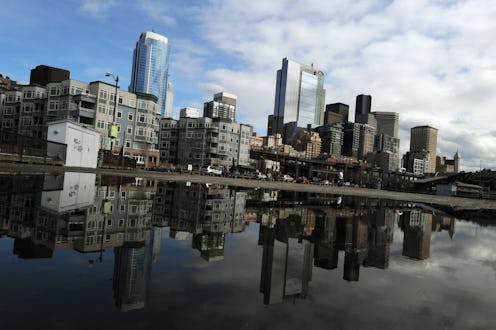News
How Much Damage Will The PNW Earthquake Cause?
In this week's issue of The New Yorker, Kathryn Schulz wrote about a massive earthquake that is set to hit the Pacific Northwest of the U.S. within 50 years, at the latest. On the low end, the earthquake is estimated to register between an 8 and an 8.6 on the Richter scale, and on the higher end, between an 8.7 and 9.2. It could affect areas as far south as northern California and as far north as Canada. Suffice it to say that this news is worrying to a lot of people. Fifty years will be within many of our lifetimes, and an earthquake of that magnitude would be devastating. While we won't know for sure until it occurs, based on current estimations, we can surmise that this next huge earthquake will severely damage the Pacific Northwest.
Even a quake as low as an 8.0 on the Richter scale is a very, very big deal. Earthquakes of this magnitude can cause severe and devastating damage, and even visible surface waves. Objects will be thrown into the air, and buildings and structures will collapse. This means that the cities near the epicenter of the earthquake could see total or nearly complete destruction. And I don't know about you, but surface waves sound utterly terrifying to me.
To put this predicted earthquake into perspective, the earthquake that hit Nepal in April of 2015 caused a death toll of well over 6,500 people, according to the BBC. The aftershocks that continued to strike kept people away from their villages, and forced them into tent cities in Nepal's capital, Kathmandu. This quake was measured as a 7.8 on the Richter scale, which is clearly a very deadly level, but still not as dangerous as the one predicted to affect the Pacific Northwest in the next half century.
One of the largest and most recent earthquakes was the 8.7 magnitude registered for the 2005 quake that hit Northern Sumatra in Indonesia. This earthquake caused a significant amount of damage, killing at least 1,200 people and completely destroying telecommunication facilities, the World Health Organization reported. Additionally, 2,000 people became homeless as a result of the quake's damage.
As for how an earthquake of this size or even larger could impact the Pacific Northwest, Schulz explained in her New Yorker piece that if this region sees the bigger earthquake, the one closer to a 9.0 on the Richter scale, the results could be significantly more devastating than even these two more recent quakes. Schulz writes:
When the next very big earthquake hits, the northwest edge of the continent, from California to Canada and the continental shelf to the Cascades, will drop by as much as six feet and rebound thirty to a hundred feet to the west—losing, within minutes, all the elevation and compression it has gained over centuries. Some of that shift will take place beneath the ocean, displacing a colossal quantity of seawater... The water will surge upward into a huge hill, then promptly collapse. One side will rush west, toward Japan. The other side will rush east, in a seven-hundred-mile liquid wall that will reach the Northwest coast, on average, fifteen minutes after the earthquake begins. By the time the shaking has ceased and the tsunami has receded, the region will be unrecognizable.
The word "unrecognizable" at the end of Schulz's description paints a horrifying picture. The mere task of accepting that this a reality not too far off into the future is overwhelming, and what it means for this region is a big question that needs to be answered pretty quickly. This earthquake could essentially redraw the map of the Northwestern United States in one fell swoop. Clearly, this issue is urgent, and we will have to wait and see what sorts of preemptive solutions are put in place to minimize the loss of life, and to contend with the potential obliteration of multiple large cities.
Images: Getty Images (3)
